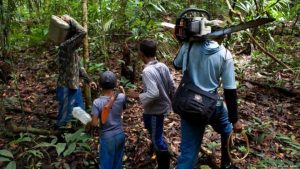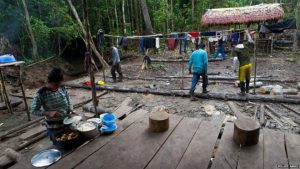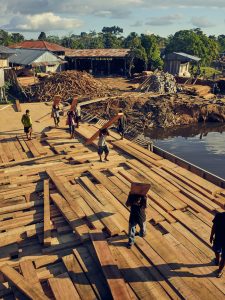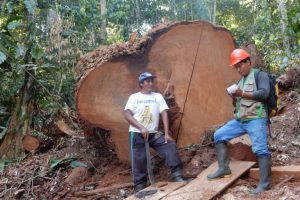3 Illegal Logging in Peru
By: Emma Wagner
In the 21st century, everything is touched by the international market including the international market for wood. In Peru, for example, the market for illegally harvested wood thrives, despite efforts to stop it. This illicit lumber market contributes greatly to the Peruvian economy as estimates suggest 80-95% of Peruvian timber exports are harvested illegally. [1] The market follows a complex supply chain that affects the lives of everyday Peruvians at each step as the wood travels from the villagers who harvest the wood eventually to eventually reach consumers throughout the world.
Peru’s geography provides the ideal location for the illegal logging market to thrive. East Peru borders Brazil, and shared among them and six other South American countries is the largest rainforest in the world, the Amazon Rainforest. The Amazon houses one in 10 species on Earth and includes over 400 billion trees. [2] In Peru, the rainforest covers 60% of the land making it an integral part of Peruvian life and the Peruvian landscape. [3]
The vastness and density of the forest provides multiple factors that enable black market logging. Smugglers remain hidden and enforcement is made more difficult. There are even camps used by harvesters located within the forest and away from the public eye. [4] In addition, the Javari River, shown in Figure 1, forms part of the Brazilian-Peruvian border providing an essential route for smugglers to float harvested logs down the river to extraction points to be sold in the global market. [5] The perception of the Amazon as an endless landscape minimizes feelings of culpability among those involved and decreases the urgency felt to stop smuggling.

Fellipe Abreu: Javari River
Historically, the Inca Empire relied on the Amazon for resources and later the Spanish also discovered economic value in the rainforest. Now, the logging industry is heavily integrated into many Peruvians’ daily lives contributing to the difficulty in stopping the vast illegal aspects of the market. Like many licit industries, participants do not see the full picture and do not understand to what extent their individual actions contribute to the black market. It remains unlikely that any part of the market is not touched by any illegal activity.
Many Peruvian towns are built on the logging market. These towns often contain established logging families due to the history of the logging industry in Peru and generations of fathers teaching their sons logging practices. [6] Due to globalization and the expansion of the international economy, the international market for Amazonian timber has grown. [7] Many logging towns contain about 300 or so people meaning the people often work together. [8] In addition to the actual loggers, others within the town benefit from the logging industry. This includes merchants who may sell basic items as well as logging material and equipment.
A typical day of a Peruvian timber harvester involves several aspects of the market. The logger wakes up early in the morning in one of many towns that survives solely on the logging industry. After a quick breakfast and a cup of coffee, male family members gather including fathers and sons and brothers and cousins as depicted in Figure 2. [9] They begin their journey into the jungle, possibly walking for several hours. Loggers cannot harvest from just anywhere. They must remain far enough away as to not negatively affect their community. If they harvest too close, the massive trees have more potential to injure someone or damage property. Loggers also understand the risk of over harvesting in one place, so as the logging season goes on they will shift locations.

Fellipe Abreu: Family Logging
Throughout the logging season a logger may meet several people. The government recognizes much of the rainforest as indigenous lands. [10] Loggers commonly visit leaders of local indigenous communities and offer something in exchange for permission to harvest within their territory. The loggers may offer a lump sum, a portion of their profits, manual labor, or even an amount of the harvested timber. [11] Over many seasons, this often creates a relationship between local indigenous peoples and specific logging towns.
Loggers also commonly create camps deep in the jungle away from the eye of law enforcement. Although, if discovered, the likelihood of getting into any real legal trouble is low as police officers commonly accept bribes. The officers may even know loggers personally given the small size and rural nature of most logging villages. [12] From a village, loggers may travel several hours to several days to get to a logging camp. It is likely that they stay for several days of work before returning home. Due to the extended stay, camps contain resources to meet a minimal level of basic need such as a basic structure to provide protection from the rain, several logs to create a place to sit, and a barren patch to build a fire. Figure 3 shows an example of what a camp looks like. Loggers generally revisit camps throughout the harvesting season. [13]

Fellipe Abreu: Logging Camp
With the normality surrounding logging in Peru and the wide reaches of illegal practices, many difficulties arise in combating the illicit market. Although the journey begins with Peruvian loggers, it quickly expands from there. Along the way, from trees in the Amazon to building materials around the world, there are many middlemen, each taking home a profit made from this illegal market. Despite the international scale, many of the known illegalities occur in Peru itself.
Loggers in small villages sell their harvest to Peruvian businessmen or entrepreneurs. These businessmen have mills where they can turn timber into lumber, or they know another businessman who can process several villages worth of timber. [14] Figure 4 shows processed lumber rather than untreated timber. After being processed, the lumber may go through several more channels involving businessmen, bribes, and forged documentation, before reaching its final Peruvian destination to be sent off to the rest of the world.

Ian Allen: Logging Mill
At this point, the lines between the illicit and licit markets begin to blur. Government officials and members of approved nongovernmental organizations inspect the lumber before it can be sent off to be sold on the international market. [15] At some point between harvesting timber to having processed lumber on a ship ready to be exported, someone would have paid for or made forged government documents certifying the wood. [16] If the lumber gets approved, as it typically does, the ship will set off and the illicit lumber will enter the licit global market.
Beyond Peru, lumber exports end up throughout the world. Main importers include China, the Dominican Republic, the United States, Mexico, and France. [17] The wood’s value on the international market stems from its large quantities and the fact that it is hard wood which can be used for a large number of purposes including structural purposes, flooring, and even furniture. After the lumber leaves Peruvian ports, it is difficult to track where it ends up and determine how it is used. While the majority of the known black market activity occurs within Peru itself throughout the supply chain, the different importers purchase the lumber through licit means. By the last step, the forged paperwork leads to government approval.
In the United States, lumber yards buy the majority of Peruvian wood. [18] The wood is then sold throughout the United States and used for anything from furniture to construction. Unbeknownst to many, illegal Amazonian wood surrounds many in the United States.
In recent years, many governments have taken action in trying to reduce the amount of Peruvian lumber exports they accept. For example, the United States developed a number of agreements with Peru to ensure increased monitoring of the illicit activity in exchange for the continued importation of Peruvian lumber. The United States also agreed to aid the Peruvian government in addressing illegal logging.
The most significant organization in the fight against the illicit logging industry in Peru is the Agency for the Supervision of Forest and Wildlife Resources (OSINFOR). [19] OSINFOR inspects lumber before it is exported out of Peru. When OSINFOR inspects a shipment they look for the necessary documents with the necessary approvals, observe the wood for signs of abnormalities including species type and size, and they question where the lumber came from and through what channels it went through before it ended up on the ship. [20] OSINFOR also inspects areas of the forest for signs of illegal logging as shown in Figure 5, they mark areas with spray paint and signs indicating the center of a radius in which logging is prohibited, and they talk with local indigenous leaders about the harmful effects of illegal logging to the rainforest. [21]

OSINFOR: OSINFOR Inspectors
OSINFOR’s success has been marked by a rocky relationship with the Peruvian government. OSINFOR is the only state agency in Peru that is successfully combating illicit logging practices in the Amazon, a feat it has been able to do due to its independence. [22] The Peruvian government continuously tries to control the organization. Theories on why include the idea that members of the Peruvian government are involved in the illegal logging trade and the idea that claiming OSINFOR’s successes will benefit Peru’s reputation on the international scale. [23]
The Peruvian illegal logging market is complex and involves many people with different roles and viewpoints. For loggers from logging villages, they feel as though they are just doing their job and doing what their fathers have done before them. For the middlemen, buying, selling, and processing timber, they only see a portion of the illicit market. For buyers outside of Peru, they are simply buying lumber to be used in their countries throughout the world. For OSINFOR inspectors, they are combating a market that is plaguing their country. The illegal Peruvian logging market affects local lives and local and global economies as people benefit from the market and others try to stop it.
[1] BAJAK, FRANK. “AP Investigation Shows Peru Backsliding on Illegal Logging.” AP NEWS. Associated Press, April 19, 2017. https://apnews.com/8f4d73bdc605446c9c64bc2aedf7aa31.
[2] “What Animals Live in the Amazon? And 8 Other Amazon Facts,” World Wildlife Fund, 2010, https://www.worldwildlife.org/stories/what-animals-live-in-the-amazon-and-8-other-amazon-facts#.
[3] Chapter 43. Tropical South America. Food and Agriculture Organization of the United Nations. Accessed October 29, 2019. http://www.fao.org/3/y1997e/y1997e1c.htm.
[4] “In Pictures: Illegal Logging in Peru.” BBC News, September 3, 2014. https://www.bbc.com/news/world-latin-america-28926270.
[5] “In Pictures: Illegal Logging in Peru.” BBC News, September 3, 2014. https://www.bbc.com/news/world-latin-america-28926270.
[6] In Pictures: Illegal Logging in Peru.” BBC News, September 3, 2014. https://www.bbc.com/news/world-latin-america-28926270.
[7] BAJAK, FRANK. “AP Investigation Shows Peru Backsliding on Illegal Logging.” AP NEWS. Associated Press, April 19, 2017. https://apnews.com/8f4d73bdc605446c9c64bc2aedf7aa31.
[8] In Pictures: Illegal Logging in Peru.” BBC News, September 3, 2014. https://www.bbc.com/news/world-latin-america-28926270.
[9] In Pictures: Illegal Logging in Peru.” BBC News, September 3, 2014. https://www.bbc.com/news/world-latin-america-28926270.
[10] “Forest Governance – Peru | Global Forest Atlas.” Yale.edu, 2011. https://globalforestatlas.yale.edu/amazon/forest-governance/peru.
[11] “Forest Governance – Peru | Global Forest Atlas.” Yale.edu, 2011. https://globalforestatlas.yale.edu/amazon/forest-governance/peru.
[12] In Pictures: Illegal Logging in Peru.” BBC News, September 3, 2014. https://www.bbc.com/news/world-latin-america-28926270.
[13] Collyns, Dan. “Aerial Pictures Reveal Rampant Illegal Logging in Peru’s Amazon Forest.” the Guardian. The Guardian, September 7, 2015. https://www.theguardian.com/environment/2015/sep/07/aerial-pictures-reveal-rampant-illegal-logging-in-perus-amazon-forest.
[14] “Peru: ‘Buyers in Good Faith’ | Global Witness.” Global Witness, 2017. https://www.globalwitness.org/en/campaigns/forests/buyers-good-faith/.
[15] Holmes, Harry. “Peru Failing to Combat Illegal Logging in Amazon Claims Report.” Occrp.org, 2019. https://www.occrp.org/en/daily/9132-peru-failing-to-combat-illegal-logging-in-amazon-claims-report.
[16] “Peru: ‘Buyers in Good Faith’ | Global Witness.” Global Witness, 2017. https://www.globalwitness.org/en/campaigns/forests/buyers-good-faith/.
[17] “OEC – Peru (PER) Exports, Imports, and Trade Partners.” Oec.world, 2017. https://oec.world/en/profile/country/per/.
[18] “OEC – Peru (PER) Exports, Imports, and Trade Partners.” Oec.world, 2017. https://oec.world/en/profile/country/per/.
[19] “Illegal Logging in Peru.” The Ecologist, January 8, 2019. https://theecologist.org/2019/jan/08/illegal-logging-peru.
[20] “Funciones – OSINFOR.” Osinfor.gob.pe, 2019. https://www.osinfor.gob.pe/quienes-somos/funciones/.
[21] “Funciones – OSINFOR.” Osinfor.gob.pe, 2019. https://www.osinfor.gob.pe/quienes-somos/funciones/.
[22] “Peru’s Forest Inspection Agency OSINFOR Regains Its Independence. But What next? | Global Witness.” Global Witness, 2019. https://www.globalwitness.org/en/blog/perus-forest-inspection-agency-osinfor-regains-its-independence-but-what-next/.
[23] “Corruption in Peru Aids Cutting of Rain Forest.” The New York Times, October 19, 2013. https://www.nytimes.com/2013/10/19/world/americas/corruption-in-peru-aids-cutting-of-rain-forest.html.

